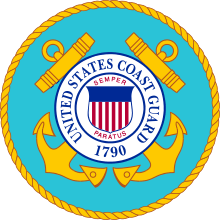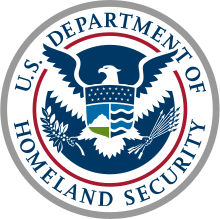United States Coast Guard
| United States Coast Guard | |
|---|---|
 | |
| Active |
4 August 1790 – present (creation of the "Revenue Marine") (226 years, 4 months)[3] and 28 January 1915 – present (merger of the "Revenue Cutter Service" and the "U.S. Life-Saving Service" to officially form the "United States Coast Guard") (101 years, 10 months)[3] |
| Country |
|
| Type | Coast guard |
| Role | Coastal defense, maritime law enforcement, search and rescue |
| Size |
Civilian employees: 8,722 Active duty personnel: 42,190 Selected reservists: 7,899 Auxiliarists: 32,000 244 cutters 1,850 boats 205 aircraft[4][5] |
| Part of |
|
| Nickname(s) | "Coasties",[12] "Shallow water sailors",[12] "The Guard",[12] |
| Motto(s) | Semper Paratus (English: Always ready) |
| Colors | White, CG Blue, CG Red[13] |
| March |
"Semper Paratus" |
| Anniversaries | 4 August |
| Engagements | |
| Decorations |
|
| Commanders | |
| Commander-in-Chief | President Barack Obama |
| Secretary of Homeland Security | The Honorable Jeh Johnson |
| Commandant | ADM Paul F. Zukunft |
| Vice Commandant | ADM Charles D. Michel |
| Master Chief Petty Officer | MCPOCG Steven W. Cantrell |
| Insignia | |
| Racing Stripe |
|
| Ensign (1953–present) |
|
| Standard |
 |
| Guidon |
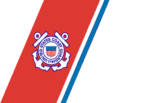 |
| Aircraft roundel and fin flash |
|
| Pennant |
|
The United States Coast Guard (USCG) is a branch of the United States Armed Forces[14] and one of the country's seven uniformed services. The Coast Guard is a maritime, military, multi-mission service unique among the U.S. military branches for having a maritime law enforcement mission (with jurisdiction in both domestic and international waters) and a federal regulatory agency mission as part of its mission set. It operates under the U.S. Department of Homeland Security during peacetime, and can be transferred to the U.S. Department of the Navy by the U.S. President at any time, or by the U.S. Congress during times of war. This has happened twice, in 1917, during World War I, and in 1941, during World War II.[8][10]
Created by Congress on 4 August 1790 at the request of Alexander Hamilton as the Revenue Marine, it is the oldest continuous seagoing service of the United States.[Note 2] As Secretary of the Treasury, Hamilton headed the Revenue Marine, whose original purpose was collecting customs duties in the nation's seaports. By the 1860s, the service was known as the U.S. Revenue Cutter Service and the term Revenue Marine gradually fell into disuse.[15]
The modern Coast Guard was formed by a merger of the Revenue Cutter Service and the U.S. Life-Saving Service on 28 January 1915, under the U.S. Department of the Treasury. As one of the country's five armed services, the Coast Guard has been involved in every U.S. war from 1790 to the Iraq War[16] and the War in Afghanistan.[17] As of 2012 the Coast Guard had approximately 42,000 men and women on active duty, 7,900 reservists, 32,000 auxiliarists, and 8,700 full-time civilian employees.[4] In terms of size, the U.S. Coast Guard by itself is the world's 12th largest naval force.[18]
The Coast Guard's legal authority differs from the other four armed services, as it operates simultaneously under Title 10 of the U.S. Code and its other organic authorities, such as Titles 6, 14, 19, 33, and 46. Because of its legal authority, the Coast Guard can conduct military operations under the U.S. Department of Defense or directly for the President in accordance with Title 14 USC 1–3. The Coast Guard's enduring roles are maritime safety, security, and stewardship. To carry out those roles, it has 11 statutory missions as defined in , which include enforcing U.S. law in the world's largest exclusive economic zone of 3.4 million square miles (8,800,000 km2).[19] The Coast Guard's motto is the Latin phrase, Semper Paratus (English: Always ready).
Mission
Role

The Coast Guard has roles in maritime homeland security, maritime law enforcement (MLE), search and rescue (SAR), marine environmental protection (MEP), the maintenance of river, intracoastal and offshore aids to navigation (ATON).
With a decentralized organization and much responsibility placed on even the most junior personnel, the Coast Guard is frequently lauded for its quick responsiveness and adaptability in a broad range of emergencies. In a 2005 article in Time magazine following Hurricane Katrina, the author wrote, "the Coast Guard's most valuable contribution to [a military effort when catastrophe hits] may be as a model of flexibility, and most of all, spirit." Wil Milam, a rescue swimmer from Alaska told the magazine, "In the Navy, it was all about the mission. Practicing for war, training for war. In the Coast Guard, it was, take care of our people and the mission will take care of itself."[20]
Missions
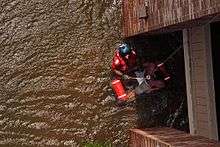
The Coast Guard carries out three basic roles, which are further subdivided into eleven statutory missions. The three roles are:
The eleven statutory missions as defined by law are divided into homeland security missions and non-homeland security missions:[21]
Non-homeland security missions
- Ice operations, including the International Ice Patrol
- Living marine resources (fisheries law enforcement)
- Marine environmental protection
- Marine safety
- Aids to navigation
- Search and rescue
Homeland security missions
- Defense readiness
- Maritime law enforcement
- Migrant interdiction
- Ports, waterways and coastal security (PWCS)
- Drug interdiction
Search and Rescue
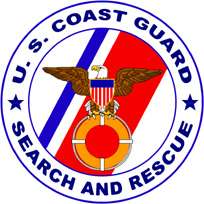
- See National Search and Rescue Committee[22]
- See Joint Rescue Coordination Centers
While not the oldest, search and rescue (SAR) is one of the Coast Guard's best known missions. The National Search and Rescue Plan[23] designates the Coast Guard as the federal agency responsible for maritime SAR operations, and the United States Air Force as the federal agency responsible for inland SAR. Both agencies maintain rescue coordination centers to coordinate this effort, and have responsibility for both military and civilian search and rescue.[24] The two services jointly provide instructor staff for the National Search and Rescue School that trains SAR mission planners and coordinators. Previously located on Governors Island, New York, the school is now located at Coast Guard Training Center Yorktown at Yorktown, Virginia.
National Response Center
Operated by the Coast Guard, the National Response Center (NRC) is the sole U.S. Government point of contact for reporting all oil, chemical, radiological, biological, and etiological spills into the environment anywhere in the United States and its territories.[25] In addition to gathering and distributing spill/incident information for Federal On Scene Coordinators and serving as the communications and operations center for the National Response Team, the NRC maintains agreements with a variety of federal entities to make additional notifications regarding incidents meeting established trigger criteria. The NRC also takes Maritime Suspicious Activity and Security Breach Reports. Details on the NRC organization and specific responsibilities can be found in the National Oil and Hazardous Substances Pollution Contingency Plan.[26] The Marine Information for Safety and Law Enforcement (MISLE) database system is managed and used by the Coast Guard for tracking pollution and safety incidents in the nation's ports.
Authority as an armed service

The five uniformed services that make up the U.S. Armed Forces are defined in Title 10 of the U.S. Code:
The term "armed forces" means the Army, Navy, Air Force, Marine Corps, and Coast Guard.[27]
The Coast Guard is further defined by Title 14 of the United States Code:
The Coast Guard as established January 28, 1915, shall be a military service and a branch of the armed forces of the United States at all times. The Coast Guard shall be a service in the Department of Homeland Security, except when operating as a service in the Navy.[28]
Coast Guard organization and operation is as set forth in Title 33 of the Code of Federal Regulations.
On 25 November 2002, the Homeland Security Act was signed into law by U.S. President George W. Bush, designating the Coast Guard to be placed under the U.S. Department of Homeland Security. The transfer of administrative control from the U.S. Department of Transportation to the U.S. Department of Homeland Security was completed the following year, on 1 March 2003.[6][29][30]
The U.S. Coast Guard reports directly to the Secretary of Homeland Security. However, under 14 U.S.C. § 3 as amended by section 211 of the Coast Guard and Maritime Transportation Act of 2006, upon the declaration of war and when Congress so directs in the declaration, or when the President directs, the Coast Guard operates under the Department of Defense as a service in the Department of the Navy.
As members of the military, Coast Guardsmen on active and reserve service are subject to the Uniform Code of Military Justice and receive the same pay and allowances as members of the same pay grades in the other uniformed services.
The service has participated in every major U.S. conflict from 1790 through today, including landing troops on D-Day and on the Pacific Islands in World War II, in extensive patrols and shore bombardment during the Vietnam War, and multiple roles in Operation Iraqi Freedom. Maritime interception operations, coastal security, transportation security, and law enforcement detachments have been its major roles in recent conflicts in Iraq.
On 17 October 2007, the Coast Guard joined with the U.S. Navy and U.S. Marine Corps to adopt a new maritime strategy called A Cooperative Strategy for 21st Century Seapower that raised the notion of prevention of war to the same philosophical level as the conduct of war.[31] This new strategy charted a course for the Navy, Coast Guard and Marine Corps to work collectively with each other and international partners to prevent regional crises, man-made or natural, from occurring, or reacting quickly should one occur to avoid negative impacts to the United States. During the launch of the new U.S. maritime strategy at the International Seapower Symposium at the U.S. Naval War College in 2007, Coast Guard Commandant Admiral Thad Allen said the new maritime strategy reinforced the time-honored missions the service has carried out in the United States since 1790. "It reinforces the Coast Guard maritime strategy of safety, security and stewardship, and it reflects not only the global reach of our maritime services but the need to integrate and synchronize and act with our coalition and international partners to not only win wars ... but to prevent wars," Allen said.[31]
Authority as a law enforcement agency

Title 14 USC, section 2 authorizes the Coast Guard to enforce U.S. federal laws.[32] This authority is further defined in 14 U.S.C. § 89, which gives law enforcement powers to all Coast Guard commissioned officers, warrant officers, and petty officers.[33] Unlike the other branches of the United States Armed Forces, which are prevented from acting in a law enforcement capacity by 18 U.S.C. § 1385, the Posse Comitatus Act, and Department of Defense policy, the Coast Guard is exempt from and not subject to the restrictions of the Posse Comitatus Act.[34]
Further law enforcement authority is given by 14 U.S.C. § 143 and 9 U.S.C. § 1401, which empower U.S. Coast Guard active and reserve commissioned officers, warrant officers, and petty officers as federal customs officers.[35][36] This places them under 19 U.S.C. § 1589a, which grants customs officers general federal law enforcement authority, including the authority to:
(1) carry a firearm;
(2) execute and serve any order, warrant, subpoena, summons, or other process issued under the authority of the United States;
(3) make an arrest without a warrant for any offense against the United States committed in the officer's presence or for a felony, cognizable under the laws of the United States committed outside the officer's presence if the officer has reasonable grounds to believe that the person to be arrested has committed or is committing a felony; and
(4) perform any other law enforcement duty that the Secretary of Homeland Security may designate.— 19 USC §1589a. Enforcement authority of customs officers[37]
The U.S. Government Accountability Office Report to the House of Representatives, Committee on the Judiciary on its 2006 Survey of Federal Civilian Law Enforcement Functions and Authorities, identified the Coast Guard as one of 104 federal components that employed law enforcement officers.[38] The report also included a summary table of the authorities of the Coast Guard's 192 special agents and 3,780 maritime law enforcement boarding officers.[39]
Coast Guardsmen have the legal authority to carry their service-issued firearms on and off base. This is rarely done in practice, however; at many Coast Guard stations, commanders prefer to have all service-issued weapons in armories when not in use. Still, one court has held that Coast Guard boarding officers are qualified law enforcement officers authorized to carry personal firearms off-duty for self-defense.[40]
History

The roots of the Coast Guard lie in the United States Revenue Cutter Service established by Alexander Hamilton under the Department of the Treasury on 4 August 1790. The first Coast Guard station was in Newburyport, Massachusetts. Until the re-establishment of the Navy in 1798, the Revenue Cutter Service was the only naval force of the early United States. It was established to collect taxes from a brand new nation of patriot smugglers. When the officers were out at sea, they were told to crack down on piracy; and to rescue any mariners in distress.[42]
"First Fleet" is a term occasionally used as an informal reference to the Coast Guard, although there is no indication that the United States has ever officially used this designation with reference either to the Coast Guard or any element of the Navy. The informal appellation honors the fact that between 1790 and 1798, there was no United States Navy and the cutters that were the predecessors of the Coast Guard were the only warships protecting the coast, trade, and maritime interests of the new republic.[43]
The modern Coast Guard can be said to date to 1915, when the Revenue Cutter Service merged with the U.S. Life-Saving Service[44] when Congress formalized the existence of the new organization. In 1939, the Lighthouse Service was brought under the Coast Guard's purview. In 1942, the Bureau of Marine Inspection and Navigation was transferred to the Coast Guard.[45] In 1967, the Coast Guard moved from the U.S. Department of the Treasury to the newly formed U.S. Department of Transportation, an arrangement that lasted until it was placed under the U.S. Department of Homeland Security in 2003 as part of legislation designed to more efficiently protect American interests following the terrorist attacks of 11 September 2001.
In times of war, the Coast Guard or individual components of it can operate as a service of the Department of the Navy. This arrangement has a broad historical basis, as the Coast Guard has been involved in wars as diverse as the War of 1812, the Mexican–American War, and the American Civil War, in which the cutter Harriet Lane fired the first naval shots attempting to relieve besieged Fort Sumter. The last time the Coast Guard operated as a whole within the Navy was in World War II. More often, military and combat units within the Coast Guard will operate under Navy or joint operational control while other Coast Guard units will remain under the Department of Homeland Security.
Organization

The new Department of Homeland Security headquarters complex is being built on the grounds of the former St. Elizabeths Hospital in the Anacostia section of Southeast Washington, across the Anacostia River from former Coast Guard headquarters.[46]
Shore establishments
Shore establishment commands exist to support and facilitate the mission of the sea and air assets. U.S. Coast Guard Headquarters is located in Southeast Washington, DC. Other shore establishments are Coast Guard Sectors (which may include Coast Guard Bases), Coast Guard Stations, Coast Guard Air Stations, and the United States Coast Guard Yard. Training centers include the United States Coast Guard Academy, Training Center Petaluma, Training Center Cape May, Coast Guard Aviation Technical Training Center, Coast Guard Aviation Training Center Mobile, and Training Center Yorktown.
Personnel
The formal name for a uniformed member of the Coast Guard is "Coast Guardsman", irrespective of gender. "Coastie" is an informal term commonly used to refer to current or former Coast Guard personnel. In 2008, the term "Guardian" was introduced as an alternative, but was later dropped. Admiral Robert J. Papp, Jr. stated that it was his belief that no Commandant had the authority to change what members of the Coast Guard are called as the term Coast Guardsman is found in Title 14 USC which established the Coast Guard in 1915.[47][Note 3] "Team Coast Guard" refers to the four components of the Coast Guard as a whole: Regular, Reserve, Auxiliary, and Coast Guard civilian employees.
Commissioned officers
Commissioned officers in the Coast Guard hold pay grades ranging from O-1 to O-10 and have the same rank structure as the Navy.[49][50] Officers holding the rank of ensign (O-1) through lieutenant commander (O-4) are considered junior officers, commanders (O-5) and captains (O-6) are considered senior officers, and rear admirals (O-7) through admirals (O-10) are considered flag officers. The Commandant of the Coast Guard and the Vice Commandant of the Coast Guard are the only members of the Coast Guard authorized to hold the rank of admiral.[51]
The Coast Guard does not have medical officers or chaplains of its own. Instead, chaplains from the U.S. Navy, as well as officers from the U.S. Public Health Service Commissioned Corps are assigned to the Coast Guard to perform chaplain-related functions and medical-related functions, respectively. These officers wear Coast Guard uniforms but replace the Coast Guard insignia with that of their own service.[52]
| Commissioned Officer grade structure of the United States Coast Guard | ||||||||||
|---|---|---|---|---|---|---|---|---|---|---|
| Admiral
(ADM) |
Vice Admiral
(VADM) |
Rear Admiral
(RADM) |
Rear Admiral (lower half) (RDML) |
Captain
(CAPT) |
Commander
(CDR) |
Lieutenant Commander (LCDR) |
Lieutenant
(LT) |
Lieutenant (junior grade) (LTJG) |
Ensign
(ENS) | |
| O-10 | O-9 | O-8 | O-7 | O-6 | O-5 | O-4 | O-3 | O-2 | O-1 | |
 |
 |
 |
 |
 |
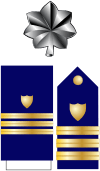 |
 |
 |
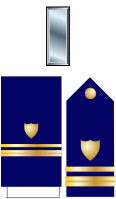 |
 | |
Warrant officers
Highly qualified enlisted personnel in pay grades E-6 through E-9 with a minimum of eight years experience can compete each year for appointment as warrant officers (WO). Successful candidates are chosen by a board and then commissioned as chief warrant officers (CWO-2) in one of sixteen specialties. Over time, chief warrant officers may be promoted to CWO-3 and CWO-4. The ranks of warrant officer (WO-1) and chief warrant officer (CWO-5) are not currently used in the Coast Guard. Chief warrant officers may also compete for the Chief Warrant Officer to Lieutenant Program. If selected, the warrant officer will be promoted to lieutenant (O-3E). The "E" designates over four years active duty service as a warrant officer or enlisted member and entitles the member to a higher rate of pay than other lieutenants.
| Warrant Officer grade structure of the United States Coast Guard | ||||||||||
|---|---|---|---|---|---|---|---|---|---|---|
| Chief Warrant Officer 4 | Chief Warrant Officer 3 | Chief Warrant Officer 2 | ||||||||
| W-4 | W-3 | W-2 | ||||||||
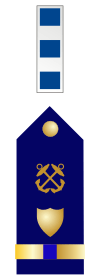 |
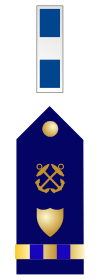 |
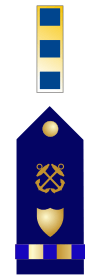 | ||||||||
Enlisted personnel
Enlisted members of the Coast Guard have pay grades from E-1 to E-9 and also follow the same rank structure as the Navy. Enlisted members in pay grades of E-4 and higher are considered petty officers and follow career development paths very similar to those of Navy petty officers.
Petty officers in pay grade E-7 and higher are chief petty officers and must attend the Coast Guard Chief Petty Officer Academy, or an equivalent Department of Defense school, in order to be advanced to pay grade E-8. The basic themes of the school are:
- Professionalism
- Leadership
- Communications
- Systems thinking and lifelong learning
| Non-commissioned officer grade structure of the United States Coast Guard Note: Crossed anchors in the graphics indicate a rating of Boatswain's Mate | ||||||||
|---|---|---|---|---|---|---|---|---|
| Master Chief Petty Officer of the Coast Guard
(MCPOCG) |
Master Chief Petty Officer of the Coast Guard Reserve Force or Area/DCO/DCMS Command Master Chief Petty Officer | Command Master Chief Petty Officer
(CMC) |
Master Chief Petty Officer
(MCPO) |
Senior Chief Petty Officer
(SCPO) |
Chief Petty Officer
(CPO) |
Petty Officer First Class
(PO1) |
Petty Officer Second Class
(PO2) |
Petty Officer Third Class
(PO3) |
| E-9 | E-8 | E-7 | E-6 | E-5 | E-4 | |||
| |
|
|
|
|
|
|
|
|
| Enlisted grade structure of the United States Coast Guard | ||||||||
| Seaman
(SN) |
Seaman Apprentice
(SA) |
Seaman Recruit
(SR) | ||||||
| E-3 | E-2 | E-1 | ||||||
 |
 |
 | ||||||
Civilian personnel
The Coast Guard employs over 7,700 civilians in over two hundred different job types including Coast Guard Investigative Service special agents, lawyers, engineers, technicians, administrative personnel, tradesmen, and federal firefighters.[53][54] Civilian employees work at various levels in the Coast Guard to support its various missions.
Women in the Coast Guard
In 1918, twin sisters Genevieve and Lucille Baker of the Naval Coastal Defense Reserve became the first uniformed women to serve in the Coast Guard.[55] Later, SPARS was the United States Coast Guard Women's Reserve created on 23 November 1942 with the signing of Public Law 773 by President Franklin Delano Roosevelt.[56] The name is a contraction of the Coast Guard motto Semper Paratus and its English translation, "Always Ready." The name also refers to a spar in nautical usage. Like the other women's reserves such as the Women's Army Corps and the WAVES, it was created to free men from stateside service in order to fight overseas. Its first director was Captain Dorothy C. Stratton who is credited with creating the name for the organization.[57] The cutter USCGC Spar is named for the SPARS.
Training
Officer training
The U.S. Coast Guard Academy is a four-year service academy located in New London, Connecticut. Approximately 225 cadets graduate each year, receiving a Bachelor of Science degree and a commission as an ensign in the Coast Guard. Graduates are obligated to serve a minimum of five years on active duty. Most graduates are assigned to duty aboard Coast Guard cutters immediately after graduation, either as Deck Watch Officers (DWOs) or as Engineer Officers in Training (EOITs). Smaller numbers are assigned directly to flight training at Naval Air Station Pensacola, Florida or to shore duty at Coast Guard Sector, District, or Area headquarters units.
In addition to the Academy, prospective officers, who already hold a college degree, may enter the Coast Guard through Officer Candidate School (OCS), also located at the Coast Guard Academy. OCS is a seventeen-week course of instruction that prepares candidates to serve effectively as officers in the Coast Guard. In addition to indoctrinating students into a military lifestyle, OCS provides a wide range of highly technical information necessary to perform the duties of a Coast Guard officer.
Graduates of OCS are usually commissioned as ensigns, but some with advanced graduate degrees may enter as lieutenants (junior grade) or lieutenants. Graduating OCS officers entering active duty are required to serve a minimum of three years, while graduating reserve officers are required to serve four years. Graduates may be assigned to a cutter, flight training, a staff job, or an operations-ashore billet.
OCS is the primary channel through which the Coast Guard enlisted grades ascend to the commissioned officer corps.
Lawyers, engineers, intelligence officers, military aviators holding commissions in other branches of the U.S. Armed Forces requesting interservice transfers to the Coast Guard, graduates of maritime academies, and certain other individuals may also receive an officer's commission in the Coast Guard through the Direct Commission Officer (DCO) program. Depending on the specific program and the background of the individual, the course is three, four or five weeks long. The first week of the five-week course is an indoctrination week. The DCO program is designed to commission officers with highly specialized professional training or certain kinds of previous military experience.
Unlike the other military services, the Coast Guard does not have a Reserve Officers' Training Corps (ROTC) program.
Recruit training
Newly enlisted personnel are sent to eight weeks of recruit training at Coast Guard Training Center Cape May in Cape May, New Jersey. New recruits arrive at Sexton Hall and remain there for three days of initial processing which includes haircuts, vaccinations, uniform issue, and other necessary entrance procedures. During this initial processing period, the new recruits are led by temporary company commanders. These temporary company commanders are tasked with teaching the new recruits how to march and preparing them to enter into their designated company. The temporary company commanders typically do not enforce any physical activity such as push ups or crunches. When the initial processing is complete, the new seaman recruits are introduced to their permanent company commanders who will remain with them until the end of training. There is typically a designated lead company commander and two support company commanders. The balance of the eight-week boot camp is spent in learning teamwork and developing physical skills. An introduction of how the Coast Guard operates with special emphasis on the Coast Guard's core values is an important part of the training.
The current nine Recruit Training Objectives are:
- Self-discipline
- Military skills
- Marksmanship
- Vocational skills and academics
- Military bearing
- Physical fitness and wellness
- Water survival and swim qualifications
- Esprit de corps
- Core values (Honor, Respect, and Devotion to Duty)
Service schools
Following graduation from recruit training, most members are sent to their first unit while they await orders to attend advanced training in Class "A" Schools. At "A" schools, Coast Guard enlisted personnel are trained in their chosen rating; rating is a Coast Guard and Navy term for enlisted skills synonymous with the Army's and Marine Corps' military occupation codes (MOS) and Air Force's Air Force Specialty Code (AFSC). Members who earned high ASVAB scores or who were otherwise guaranteed an "A" School of choice while enlisting may go directly to their "A" School upon graduation from Boot Camp.
Equipment
Cutters
.jpeg)

Originally, the U.S. Coast Guard used the term cutter in its traditional sense, as a type of small sailing ship. Today it officially uses the term for any vessel that has a permanently assigned crew and accommodations for the extended support of that crew, and includes only and all vessels of 65 feet (20 m) or more in length.[58]
- Polar-class icebreaker (WAGB): There are three WAGB's used for icebreaking and research though only two, the heavy 399-foot (122 m) Polar Star and the newer medium class 420-foot (130 m) Healy, are active.[59][60][61][62] Polar Sea is located in Seattle, Washington but is not currently in active service.
- National Security Cutter (WMSL): These are a new class of 418-foot (127 m) military defense, maritime ship, also known as the Legend-class cutter. At 418 ft. these are the largest USCG military cutters in active service. One-for-one Legend-class ships are replacing individually decommissioned 1960s Hamilton-class high endurance cutters. A total of eight were authorized and budgeted; as of 2015 three are in service, and three are under construction.
- High Endurance Cutter (WHEC): These are 12 378-foot (115 m) Hamilton-class cutters commissioned in the late 1960s. Missions include law enforcement, search and rescue, and military defense. These aged cutters are individually being decommissioned and replaced by the new 418 ft. National Security Cutters.
- Medium Endurance Cutter (WMEC): These are mostly the 210-foot (64 m) Reliance class, and the 270-foot (82 m) Famous class cutters, although the 283-foot (86 m) Alex Haley also falls into this category. Primary missions are law enforcement, search and rescue, and military defense.
- USCGC Mackinaw: A 240-foot (73 m) heavy icebreaker built for operations on the Great Lakes.
- USCGC Eagle: A 295-foot (90 m) sailing barque used as a training ship for Coast Guard Academy cadets and Coast Guard officer candidates. She was originally built in Germany as Horst Wessel, and was seized by the United States as a prize of war in 1945.[63]
- Seagoing Buoy Tender (WLB): These 225-foot (69 m) ships are used to maintain aids to navigation and also assist with law enforcement and search and rescue.
- Coastal Buoy Tender (WLM): The 175-foot (53 m) Keeper-class coastal buoy tenders are used to maintain coastal aids to navigation.
- Sentinel class cutter (WPC): The 154-foot (47 m) Sentinel class was previously known as the "Fast Response Cutter" class and is used for search and rescue work and law enforcement.
- Bay-class icebreaking tug (WTGB): 140-foot (43 m) icebreakers used primarily for domestic icebreaking missions. Other missions include search and rescue, law enforcement, and aids to navigation maintenance.[64]
- Patrol Boats (WPB): There are two classes of WPBs currently in service; the 110-foot (34 m) Island-class patrol boats and the 87-foot (27 m) Marine Protector-class patrol boats[65][66]
Aircraft

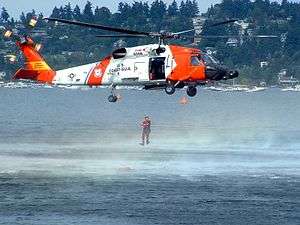
.jpg)
The Coast Guard operates approximately 204 fixed and rotary wing aircraft from 24 Coast Guard Air Stations throughout the contiguous United States, Alaska, Hawaii, and Puerto Rico. Most of these air stations are tenant activities at civilian airports, several of which are former Air Force Bases and Naval Air Stations, although several are also independent military facilities. Coast Guard Air Stations are also located on active Naval Air Stations, Air National Guard bases, and Army Air Fields.
Coast Guard aviators receive Primary (fixed-wing) and Advanced (fixed or rotary-wing) flight training with their Navy and Marine Corps counterparts at NAS Whiting Field, Florida, and NAS Corpus Christi, Texas, and are considered Naval Aviators. After receiving Naval Aviator Wings, Coast Guard pilots, with the exception of those slated to fly the HC-130, report to U.S. Coast Guard Aviation Training Center, Mobile, Alabama to receive 6–12 weeks of specialized training in the Coast Guard fleet aircraft they will operate. HC-130 pilots report to Little Rock AFB, Arkansas, for joint C-130 training under the auspices of the 314th Airlift Wing of the U.S. Air Force.
Fixed-wing aircraft operate from Air Stations on long-duration missions. Helicopters operate from Air Stations and can deploy on a number of different cutters. Helicopters can rescue people or intercept vessels smuggling migrants or narcotics. Since the terrorist attacks of 11 September 2001, the Coast Guard has developed a more prominent role in national security and now has armed helicopters operating in high risk areas for the purpose of maritime law enforcement and anti-terrorism.
The Coast Guard is now developing an unmanned aerial vehicle (UAV) program that will utilize the MQ-9 Reaper platform for homeland security and search/rescue operations. To support this endeavor, the Coast Guard has partnered with the Navy and U.S. Customs and Border Protection to study existing/emerging unmanned aerial system (UAS) capabilities within their respective organizations. As these systems mature, research and operational experience gleaned from this joint effort will enable the Coast Guard to develop its own cutter and land-based UAS capabilities.
Fixed-Wing Aircraft:
- Lockheed HC-130H Hercules[67]
- Lockheed HC-130J Super Hercules[68]
- CASA HC-144A Ocean Sentry[69]
- Alenia C-27J Spartan
Rotary-Wing Aircraft:
Fixed-Wing VIP Transport Aircraft assigned to CGAS Washington D.C:
- VC-37A Long Range Command and Control Aircraft (2 airframes as of December 2011: CG-01, S/N 653 and CG-02, S/N 638)[72]

Boats

The Coast Guard operates about 1,400 boats, defined as any vessel less than 65 feet (20 m) long, which generally operate near shore and on inland waterways.
The Coast Guard boat fleet includes:
- Motor Life Boat (MLB): The Coast Guard's 47-foot (14 m) primary heavy-weather boat used for search and rescue as well as law enforcement and homeland security.
- Response Boat – Medium (RB-M): A new multi-mission 45-foot (14 m) vessel intended to replace the 41-foot (12 m) utility boat. 170 planned
- Special Purpose Craft – Near Shore Lifeboat: Only 2 built. Shallow draft, 42-foot (13 m) lifeboat substituted for the 47-foot (14 m) Motor Life Boat, based at Chatham, Massachusetts[73]
- Long Range Interceptor (LRI): A 36-foot (11 m) high-speed launch that can be launched from the stern ramps of the larger Deepwater cutters.
- Aids to Navigation Boats (TANB/BUSL/ANB/ANB): Various designs ranging from 26 to 55 feet (7.9 to 16.8 m) used to maintain aids to navigation.
- Special Purpose Craft – Law Enforcement (SPC-LE): Intended to operate in support of specialized law enforcement missions, utilizing three 300 horsepower (220 kW) Mercury Marine engines. The SPC-LE is 33 feet (10 m) long and capable of speeds in excess of 50 knots (93 km/h; 58 mph) and operations more than 30 miles (48 km) from shore.
- Response Boat – Small (RB-S): A 25-foot (7.6 m) high-speed boat, for a variety of missions, including search and rescue, port security and law enforcement duties.
- Transportable Port Security Boat (TPSB): A 25-foot (7.6 m) well-armed boat used by Port Security Units for force protection.
- SPC-SW Special Purpose Craft, Shallow-water: 24 feet (7.3 m)
- Over-the-Horizon (OTH) boat: A 23-foot (7.0 m) rigid hull inflatable boat used by medium and high endurance cutters and specialized units.
- Short Range Prosecutor (SRP): A 23-foot (7.0 m) rigid hull inflatable boat that can be launched from a stern launching ramp on the National Security Cutters.
Weapons

The U.S. Coast Guard uses a wide variety of small arms. Handguns, shotguns, and rifles are used to arm boat crew and boarding team members and machine guns are mounted aboard cutters, boats, and helicopters.
Common small arms include:
- SIG Sauer P229R DAK .40 S&W pistol
- Remington M870P 12 gauge shotgun
- M16A2 rifle
- M4 carbine
- M14 Tactical rifle
- FN M240 machine gun
- M2 heavy machine gun
Deployable Specialized Forces also employ specialized weapons including the Mk 18 carbine, Mk 11 precision rifle, and M203 grenade launcher. Marksmen from the Helicopter Interdiction Tactical Squadron and Law Enforcement Detachments use a variant of the Barrett M107 .50-caliber rifle to disable the engines on fleeing boats.
Symbols
Core values
The Coast Guard, like the other armed services of the United States, has a set of core values that serve as basic ethical guidelines for all Coast Guard active duty, reservists, auxiliarists, and civilians. The Coast Guard Core Values are:
Honor: Integrity is our standard. We demonstrate uncompromising ethical conduct and moral behavior in all of our personal actions. We are loyal and accountable to the public trust.
Respect: We value our diverse workforce. We treat each other with fairness, dignity and compassion. We encourage individual opportunity and growth. We encourage creativity through empowerment. We work as a team.
Devotion to Duty: We are professionals, military and civilian, who seek responsibility, accept accountability, and are committed to the successful achievement of our organizational goals. We exist to serve. We serve with pride.— Coast Guard Core Values[74]
The Guardian Ethos
In 2008, the Coast Guard introduced the Guardian Ethos. As the Commandant, Admiral Allen noted in a message to all members of the Coast Guard: [The Ethos] "defines the essence of the Coast Guard," and is the "contract the Coast Guard and its members make with the nation and its citizens."[75]
The Coast Guard Ethos
In an ALCOAST message effective 1 December 2011 the Commandant, Admiral Papp, directed that the language of Guardian Ethos be superseded by the Coast Guard Ethos in an effort to use terminology that would help with the identity of personnel serving in the Coast Guard.[76] The term Coast Guardsman is the correct form of address used in Title 14 USC and is the form that has been used historically. This changed the line in the Guardian Ethos "I am a Guardian." to become "I am proud to be a Coast Guardsman."[77]
The Ethos is as follows:
I am a Coast Guardsman.
I serve the people of the United States.
I will protect them.
I will defend them.
I will save them.
I am their shield.
For them I am Semper Paratus.
I live the Coast Guard core values.
I am proud to be a Coast Guardsman.
We are the United States Coast Guard.— The Coast Guard Ethos[48]
Creed of the United States Coast Guardsman
The "Creed of the United States Coast Guardsman" was written by Vice Admiral Harry G. Hamlet, who served as Commandant of the Coast Guard from 1932 to 1936.[78]
I am proud to be a United States Coast Guardsman.
I revere that long line of expert seamen who by their devotion to duty and sacrifice of self have made it possible for me to be a member of a service honored and respected, in peace and in war, throughout the world.
I never, by word or deed, will bring reproach upon the fair name of my service, nor permit others to do so unchallenged.
I will cheerfully and willingly obey all lawful orders.
I will always be on time to relieve, and shall endeavor to do more, rather than less, than my share.
I will always be at my station, alert and attending to my duties.
I shall, so far as I am able, bring to my seniors solutions, not problems.
I shall live joyously, but always with due regard for the rights and privileges of others.
I shall endeavor to be a model citizen in the community in which I live.
I shall sell life dearly to an enemy of my country, but give it freely to rescue those in peril.
With God's help, I shall endeavor to be one of His noblest Works...
A UNITED STATES COAST GUARDSMAN.— Creed of the United States Coast Guardsman[79]
"You have to go out, but you don't have to come back!"
This unofficial motto of the Coast Guard dates to an 1899 United States Lifesaving Service regulation, which states in part: "In attempting a rescue, ... he will not desist from his efforts until by actual trial, the impossibility of effecting a rescue is demonstrated. The statement of the keeper that he did not try to use the boat because the sea or surf was too heavy will not be accepted, unless attempts to launch it were actually made and failed."[80]
Coast Guard Ensign

.png)
The Coast Guard Ensign (flag) was first flown by the Revenue Cutter Service in 1799 to distinguish revenue cutters from merchant ships. A 1 August 1799 order issued by Secretary of the Treasury, Oliver Wolcott, Jr. specified that the Ensign would be "sixteen perpendicular stripes (for the number of states in the United States at the time), alternate red and white, the union of the ensign to be the arms of the United States in a dark blue on a white field."[81]
This ensign became familiar in American waters and served as the sign of authority for the Revenue Cutter Service until the early 20th century. The ensign was originally intended to be flown only on revenue cutters and boats connected with the Customs Service but over the years it was found flying atop custom houses as well, and the practice became a requirement in 1874. On 7 June 1910, President William Howard Taft issued an Executive Order adding an emblem to (or "defacing") the ensign flown by the Revenue cutters to distinguish it from what is now called the Customs Ensign flown from the custom houses. The emblem was changed to the official seal of the Coast Guard in 1927.[82][83]
The purpose of the ensign is to allow ship captains to easily recognize those vessels having legal authority to stop and board them. It is flown only as a symbol of law enforcement authority and is never carried as a parade standard.[84]
Coast Guard Standard

The Coast Guard Standard is used in parades and carries the battle honors of the Coast Guard. It was derived from the jack of the Coast Guard ensign which was flown by revenue cutters. The emblem is a blue eagle from the coat of arms of the United States on a white field. Above the eagle are the words "UNITED STATES COAST GUARD" below the eagle is the motto, "SEMPER PARATUS" and the inscription "1790."
Service Mark ("Racing Stripe")

The racing stripe is borne by Coast Guard cutters, aircraft, and many boats. Red-hulled icebreaker cutters and most HH-65/MH-65 helicopters (i.e., those with a red fuselage) bear a narrow white bar, a narrow blue bar, and broad CG red bar, with the Coast Guard shield centered. Conversely, black-hulled cutters (such as buoy tenders and inland construction tenders) use the standard racing stripe. Auxiliary vessels maintained by the Coast Guard also carry the Racing Stripe, but in inverted colors (i.e., broad blue stripe with narrow white and CG red stripes) and the Auxiliary shield.
The Racing Stripe, officially known as the Service Mark, was designed in 1964 by the industrial design office of Raymond Loewy Associates to give the Coast Guard a distinctive, modern image. Loewy had designed the colors for the Air Force One fleet for Jackie Kennedy. President Kennedy was so impressed with his work, he suggested that the entire Federal Government needed his make-over and suggested that he start with the Coast Guard.[85] First used and placed into official usage as of April 6, 1967, it consists of a narrow blue stripe, a narrow white stripe between, and a broad CG red bar with the Coast Guard shield centered.[13][86][87] The stripes are canted at a 64 degree angle, coincidentally the year the Racing Stripe was designed.[88]
Similar Racing Stripe designs have been adopted for the use of other coast guards and maritime authorities and many other law enforcement and rescue agencies.
Semper Paratus
The official march of the Coast Guard is "Semper Paratus" (Latin for "Always Ready").[89]
Colors
Two Pantone colors are named after the Coast Guard; they are used in the Service Mark.[13]
- CG Red is Pantone 179C (hex color code #E23D28)
- CG Blue is Pantone 307C[13] (hex color code #007AA5)[90]
Uniforms

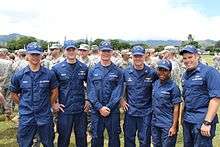
Prior to 1974, Coast Guard personnel wore the same uniforms as the Navy with distinctive Coast Guard insignia, primarily distinctive cap devices for officers and chief petty officers, incorporation of the Coast Guard shield in lieu of line or staff corps insignia for officers, and different buttons on dress uniforms.
In 1974, the current Coast Guard Service Dress Blue (SDB) uniform was introduced for wear by both officers and enlisted personnel; the transition was completed during 1974. The uniform consists of a blue four-pocket single breasted jacket and trousers. A light-blue button-up shirt with a pointed collar, two front button-flap pockets, and shoulder loops, along with a tie of the same shade as the jacket are worn with the uniform. Officer rank insignia parallels that of the Navy but with the gold Navy line star replaced with the gold Coast Guard Shield and with the Navy blue background color replaced by Coast Guard blue. Enlisted rank insignia is also similar to the Navy with the Coast Guard shield replacing the petty officer's eagle on collar and cap devices for petty officers or enlisted rating insignia for seamen qualified as a "designated striker". Group Rate marks (stripes) for junior enlisted members (E-3 and below) also follow Navy convention with white for seaman, red for fireman, and green for airman. In a departure from the Navy conventions, all petty officers E-6 and below wear red chevrons and all chief petty officers wear gold. Unlike the Navy, there are no khaki uniforms, and all personnel wear the same color uniform.[91]
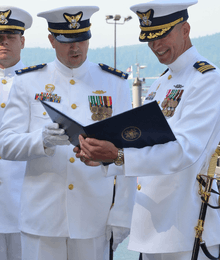
The SDB uniform may be worn year-round for business within the Coast Guard and for social occasions where the civilian equivalent is coat and tie.[92]
The Tropical Blue variation, worn in warm weather, omits the jacket and tie, and features a short sleeve shirt with rank insignia on shoulder boards for officers, and pin-on collar insignia for petty officers. The Tropical Blue uniform may be worn year-round for general office wear and for visits between commands. It may be worn in lieu of the SDB uniform, but not to functions where civilian dress is coat and tie.[92]
Coast Guard officers also have dress white uniforms, nearly identical to the choker white uniforms worn by naval officers (aside from service-specific buttons, insignia and sword design), typically used for formal parade and change-of-command ceremonies. For similar occasions enlisted members wear Tropical Blue, Service Dress Blue, or Full Dress Blue. Full Dress Blue replaces the light blue shirt with a white shirt, and full size medals are worn on the jacket. A white belt may be worn for honor guards. Mess dress uniforms are worn by members for formal (black tie) evening ceremonies. Like the officers' dress white uniforms, the mess dress uniforms are identical to those of the Navy, aside from Coast Guard-specific insignia.
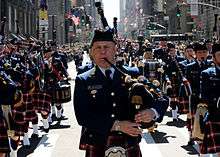
The current working uniform of the Coast Guard is the Operational Dress Uniform (ODU). The ODU may be worn year-round primarily as a field utility and watchstanding uniform, and may be worn in an office environment. The ODU is similar to the Battle Dress Uniform of other armed services, both in function and style. However, the ODU is in a solid dark blue with no camouflage pattern and does not have lower pockets on the blouse. The first generation ODU, wearable until 1 July 2012 was worn tucked in. The second generation ODU is worn untucked and has black Coast Guard insignia embroidered on the left shirt pocket as well as the side pockets of the trousers. The ODU is worn with composite-toed boots in most circumstances, but low-cut brown boat shoes may be prescribed for certain vessel boarding operations. A standard baseball-style ball cap is worn, embroidered in gold block lettering with "U.S. Coast Guard." Units may also additionally authorize ball caps with the unit name embroidered for wear while on the unit. A foul weather parka is the outerwear worn with the ODU. The former dark blue working uniform has been withdrawn from use by the Coast Guard but may be worn by Auxiliarists until no longer serviceable.
Coast Guard personnel serving in expeditionary combat units such as Port Security Units, Law Enforcement Detachments, and others, wear the Camouflage Utility Uniform (CUU) with the woodland or desert pattern/color scheme based on the operational commander's guidance. An eight-point cap is worn with rank insignia. The camouflaged utility sun hat may be worn when prescribed by the operational commander, without rank insignia.

All Coast Guardsmen wear the combination cap with all uniforms except the ODU and CUU. Company commanders (the Coast Guard's equivalent of drill sergeants) at Training Center Cape May wear the traditional Smokey Bear-style campaign hat.
The Coast Guard Pipe Band, a special musical unit composed of active, reserve and auxiliary coast guardsmen, wears a modified form of highland dress, including kilt and sporran. It is, along with the Band of the Air Force Reserve Pipe Band, one of only two kilted units in the United States military, excluding those maintained by state defense forces and service academies. The band's kilt is patterned in the official U.S. Coast Guard tartan, which is registered with the Scottish Register of Tartans.[93]
Cadets at the U.S. Coast Guard Academy have access to standard Coast Guard uniforms, including Service Dress Blues and the ODU, however, also wear two different styles of parade dress uniforms. Fall Parade Dress Blue consists of navy blouses with banded collars and double rows of buttons, worn with matching navy trousers and a white peaked hat. Spring Parade Dress Blue substitutes white trousers in lieu of navy.
Deployable Operations Group
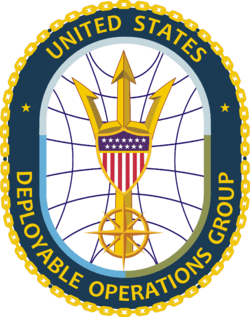
The Deployable Operations Group (DOG) was a Coast Guard command established in July 2007. The DOG established a single command authority to rapidly provide the Coast Guard, Department of Homeland Security, Department of Defense, Department of Justice and other interagency operational commanders adaptive force packages drawn from the Coast Guard's deployable specialized force units. The DOG was disestablished on 22 April 2013 and its deployable specialized forces (DSF) units were placed under the control of the Atlantic and Pacific Area Commanders.[94]
The planning for the unit began after the terrorist attacks of 11 September 2001, and culminated with its formation on 20 July 2007. Its missions include maritime law enforcement, anti-terrorism, port security, pollution response, and diving operations.
There were over 25 specialized units within the Deployable Operations Group including the Maritime Security Response Team, Maritime Safety and Security Teams, Law Enforcement Detachments, Port Security Units, the National Strike Force, and Regional Dive Lockers. The DOG also managed Coast Guard personnel assigned to the Navy Expeditionary Combat Command and was involved in the selection of Coast Guard candidates to attend Navy BUD/S and serve with Navy SEAL Teams.[95]
Coast Guard Reserve

The United States Coast Guard Reserve is the reserve military force of the Coast Guard.[96] The Coast Guard Reserve was founded on 19 February 1941. Coast Guard reservists normally drill two days a month and an additional 12 days of active duty each year, although many perform additional drill and active duty periods, to include those mobilized to extended active duty. Coast Guard reservists possess the same training and qualifications as their active duty counterparts, and as such, can be found augmenting active duty Coast Guard units every day.
During the Vietnam War and shortly thereafter, the Coast Guard considered abandoning the reserve program, but the force was instead reoriented into force augmentation, where its principal focus was not just reserve operations, but to add to the readiness and mission execution of every-day active duty personnel.
Since 11 September 2001, over 8,500 reservists have been activated and served on tours of active duty, to include deployments to the Persian Gulf and also as parts of Department of Defense combatant commands such as the U.S. Northern and Central Commands. Coast Guard Port Security Units are entirely staffed with reservists, except for five to seven active duty personnel. Additionally, most of the staffing the Coast Guard provides to the Navy Expeditionary Combat Command are reservists.
The Reserve is managed by the Director of Reserve and Military Personnel Directorate, Rear Admiral Kurt B. Hinrichs, USCGR.
Coast Guard Auxiliary

The United States Coast Guard Auxiliary is the uniformed volunteer component of the Coast Guard, established on 23 June 1939 by an act of Congress as the United States Coast Guard Reserve, it was re-designated as the Auxiliary on 19 February 1941. It works within the Coast Guard in carrying out its noncombatant and non-law enforcement missions.[97] Auxiliarists are subject to direction from the Commandant of the Coast Guard making them unique among all federal volunteers (e.g. Air Force's Civil Air Patrol and FBI's InfraGard). As of 2012, there were approximately 32,000 active Auxiliarists.[4] The Coast Guard has assigned primary responsibility for many recreational boating safety tasks to the Auxiliary, including public boating safety education and voluntary vessel safety checks called Courtesy Marine Examinations and Personal Watercraft Safety Checks.[98]
Prior to 1997, Auxiliarists were limited to those tasks and on-water patrols supporting recreational boating safety. In 1997, however, new legislation authorized the Auxiliary to participate in any and all Coast Guard missions except direct military and direct law enforcement.[99] Auxiliarists may support the law enforcement mission of the Coast Guard but may not directly participate in it, and Auxiliarists and their vessels are not permitted to carry a weapon while serving in any Auxiliary capacity. Auxiliarists use their own vessel (e.g., boats, aircraft, and vehicles), once it is registered as a Coast Guard Facility, in Coast Guard missions.
Medals and honors
One Coast Guardsman, Douglas Albert Munro, has earned the Medal of Honor, the highest military award of the United States.[100] Fifty five Coast Guardsmen have earned the Navy Cross and numerous men and women have earned the Distinguished Flying Cross.
The highest peacetime decoration awarded within the Coast Guard is the Homeland Security Distinguished Service Medal; prior to the transfer of the Coast Guard to the Department of Homeland Security, the highest peacetime decoration was the Department of Transportation Distinguished Service Medal. The highest unit award available is the Presidential Unit Citation.
In wartime, members of the Coast Guard are eligible to receive the Navy version of the Medal of Honor. A Coast Guard Medal of Honor is authorized but has not yet been developed or issued.
In May 2006, at the Change of Command ceremony when Admiral Thad Allen took over as Commandant, President George W. Bush awarded the entire Coast Guard, including the Coast Guard Auxiliary, the Coast Guard Presidential Unit Citation with hurricane device, for its efforts during and after Hurricane Katrina and Tropical Storm Rita.
Organizations
Coast Guard Aviation Association
Those who have piloted or flown in Coast Guard aircraft under official flight orders may join the Coast Guard Aviation Association which was formerly known as the "Ancient Order of the Pterodactyl" ("Flying Since the World was Flat").
The Ancient Albatross Award is presented to the active duty USCG member who qualified as an aviator earlier than any other person who is still serving. Separate enlisted and officer awards are given.[101][102]
Coast Guard CW Operators Association
The Coast Guard CW Operators Association (CGCWOA) is a membership organization comprising primarily former members of the United States Coast Guard who held the enlisted rating of Radioman (RM) or Telecommunications Specialist (TC), and who employed International Morse Code (CW) in their routine communications duties on Coast Guard cutters and at shore stations.[103]
USCG Chief Petty Officers Association
Members of this organization unite to assist members and dependents in need, assist with Coast Guard recruiting efforts, support the aims and goals of the Coast Guard Chief Petty Officers Academy, keep informed on Coast Guard matters, and assemble for social amenities; and include Chief, Senior Chief, and Master Chief Petty Officers, active, reserve and retired. Membership is also open to all Chief Warrant Officers and Officers who have served as a Chief Petty Officer.[104]
USCG Chief Warrant and Warrant Officers Association (CWOA)
Established in 1929, the Chief Warrant and Warrant Officers Association, United States Coast Guard (CWOA) represents Coast Guard warrant and chief warrant officers (active, reserve and retired) to the Congress, White House and the Department of Homeland Security. Additionally, the association communicates with the Coast Guard leadership on matters of concern to Coast Guard chief warrant officers.[105]
Notable Coast Guardsmen
Numerous celebrities have served in the Coast Guard including tennis player Jack Kramer, golfer Arnold Palmer, All Star baseball player Sid Gordon, boxer Jack Dempsey; musicians Kai Winding, Rudy Vallee,[106] Derroll Adams, and Tom Waits; actors Buddy Ebsen, Sid Caesar, Victor Mature, Richard Cromwell, Alan Hale, Jr., William Hopper, Beau Bridges, Cesar Romero; author Alex Haley; and Senator Claiborne Pell.
Vice Admiral Thad Allen in 2005 was named Principal Federal Officer to oversee recovery efforts in the Gulf Region after Hurricane Katrina. After promotion to Admiral, on the eve of his retirement as Commandant, Allen again received national visibility after being named National Incident Commander overseeing the response efforts of the Deepwater Horizon oil spill.
Former Coast Guard officers have been appointed to numerous civilian government offices. After retiring as Commandant of the Coast Guard in 2002, Admiral James Loy went on to serve as administrator of the Transportation Security Administration and later as Deputy Secretary of the Department of Homeland Security. Admiral Loy was by no means the only Coast Guard officer who was later appointed to a civilian government position; following his Coast Guard career, Carlton Skinner served as the first Civilian Governor of Guam; G. William Miller, 65th Secretary of the Treasury was a graduate of the Coast Guard Academy, and retired Vice Admiral Harvey E. Johnson, Jr. served as Deputy Administrator and Chief Operating Officer of the Federal Emergency Management Agency (FEMA) under President George W. Bush. Rear Admiral Stephen W. Rochon was appointed by President George W. Bush to serve as the Director of the Executive Residence and White House Chief Usher, beginning service on 12 March 2007, and continues to serve in the same capacity under President Barack Obama.
Two Coast Guard aviators, Commander Bruce E. Melnick and Captain Daniel C. Burbank, have served as NASA astronauts.
Signalman First Class Douglas Albert Munro was awarded the Medal of Honor posthumously, and is the only Coast Guardsman to ever receive this honor.[100]
In popular culture
In literature
- A Coast Guard cutter and its commanding officer and crew figured prominently in Tom Clancy's books Clear and Present Danger, Without Remorse, and Executive Orders.
- Sinbad, a dog serving aboard the cutter USCGC Campbell in WWII, who was enlisted and held the rank of Chief Petty Officer, was the first member of the United States Coast Guard to be the subject of a biography in George Foley's Sinbad of the Coast Guard in 1945.
- The Coast Guard training cutter, USCGC Eagle, figures prominently in S.M. Stirling's book Island in the Sea of Time.
- The 2009 book The Finest Hours by Casey Sherman and Michael J. Tougias describes the 1952 Pendleton rescue off the New England coast.
In film
- Fighting Coast Guard, a 1951 drama, depicts Coast Guard trained to help win WWII.
- Onionhead, a 1957 comedy, portrayes Andy Griffith as a Coast Guard recruit.
- The Boatniks, a 1970 Disney comedy film, depicts Ensign Tom Garland, played by Robert Morse, as the commander of a small cutter on the West Coast.
- Satan's Triangle, a 1975 TV movie, involves a United States Coast Guard helicopter sent to answer a distress call from inside the Bermuda Triangle.
- The Island (1980). Latter-day Caribbean pirates capture the (fictional) cutter USCGC New Hope. Filming was done on USCGC Dauntless.
- The Perfect Storm, 2000 film, depicted the rescue operations of the USCGC Tamaroa as one of its subplots.
- Bad Boys II, 2003 film, depicts counter-drug helicopters from the Helicopter Interdiction Tactical Squadron (HITRON).
- Yours, Mine, and Ours, 2005 family comedy, Dennis Quaid plays a fictional U.S. Coast Guard Academy superintendent who marries a character played by Rene Russo; together, they have 18 children.
- The Guardian, 2006 film, starring Kevin Costner and Ashton Kutcher, was based on the training and operations of Coast Guard Aviation Survival Technicians.
- Pain & Gain, 2013 film, starring Dwayne Johnson and Mark Wahlberg, depicted the Coast Guard Deployable Operations Group in action.
- The Finest Hours, 2016 film based on the 2009 book by Casey Sherman and Michael J. Tougias about the 1952 Pendleton rescue off the New England coast.
On television
The Coast Guard has been featured in several television series, including *The Amazing Race 25, Baywatch, "Burn Notice", CSI: Miami, Deadliest Catch, Dirty Jobs, Harbor Command, Miami Vice, NCIS NCIS: New Orleans and Person of Interest.
Other shows include :
- Coast Guard was a syndicated television series that aired for three seasons from 1995 to 1997 in the United States as well as overseas, where it was called Sea Rescue. The series followed Coast Guard personnel as they performed their missions.[107][108][109]
- Coast Guard Alaska: Search and Rescue, a series on The Weather Channel that features a Coast Guard search-and-rescue unit based in Kodiak, Alaska.
- Coast Guard Cape Disappointment: Pacific Northwest, a series in production on The Weather Channel that features Coast Guard Station Cape Disappointment based in Ilwaco, Washington and Coast Guard Air Station Astoria in Warrenton, Oregon.
- Coast Guard Florida: Search and Rescue, a series in production on The Weather Channel that features Coast Guard search-and-rescue units based in Miami and Clearwater, Florida.
- Emergency!, Coast Guard HH-52 Seaguard helicopters and boats were used in various rescues.
- Flipper, various Coast Guard HH-52 Seaguard helicopters were used..
- Hawaii Five-0, featured several episodes in which the Five-0 team worked with Station Honolulu[110] and Air Station Barbers Point.[111]
- Popeye was in the Coast Guard after being a Merchant Mariner. He later joined the Navy.
- Unnamed Coast Guardsmen of a Law Enforcement Detachment were featured in a Channel 5 documentary Royal Navy Caribbean Patrol. They were serving aboard HMS Manchester, a British Royal Navy ship combating drug smugglers in the Caribbean.
See also
Coast Guard
- AMVER
- Badges of the United States Coast Guard
- Chaplain of the Coast Guard
- Coast Guard Day
- Code of Federal Regulations, Title 33
- Joint Maritime Training Center
- List of United States Coast Guard cutters
- Maritime Law Enforcement Academy
- MARSEC
- National Data Buoy Center
- National Ice Center
- Naval militia
- North Pacific Coast Guard Agencies Forum
- Patrol Forces Southwest Asia
- SPARS
- U.S. Coast Guard Intelligence
- U.S. Coast Guard Legal Division
- United States Coast Guard Air Stations
- United States Coast Guard Police
- United States Coast Guard Research & Development Center
- United States Coast Guard Stations
- Women in the United States Coast Guard
Related agencies
- List of United States federal law enforcement agencies
- National Oceanic and Atmospheric Administration Fisheries Office for Law Enforcement
- U.S. Customs and Border Protection (CBP)
- U.S. Immigration and Customs Enforcement (ICE)
- U.S. Marine Corps
- U.S. Maritime Administration
- U.S. Merchant Marine
Notes
- ↑ Prior to the formation of the modern U.S. Coast Guard by merger of the U.S. Revenue Cutter Service and the U.S. Life-Saving Service in 1915, the Revenue Cutter Service had been under the control of the U.S. Department of the Treasury from its creation in 1790. The U.S. Life-Saving Service dated from 1871 and was also under the control of the U.S. Department of the Treasury.
- ↑ Although the U.S. Navy lists its founding as 1775 with the formation of the Continental Navy, that service was disbanded in 1785 and the modern U.S. Navy in its present form was founded in 1794.
- ↑ The term Coast Guardsman is the official term used by the U.S. Coast Guard to refer to a member regardless of the person's gender. In an ALCOAST message effective 1 December 2011 the Commandant, Admiral Papp, directed that the language of the Guardian Ethos be superseded by the Coast Guard Ethos in an effort to use terminology that would help with the identity of personnel serving in the Coast Guard. The term Coast Guardsman is the correct form of address used in Title 14 USC and is the form that has been used historically.[48]
References
- ↑ Johnson, Lyndon Baines (9 December 1966). "Executive Order 11319". Washington, D.C. Retrieved 27 March 2015.
- ↑ "Executive Order 10707". Washington, D.C.: National Archives. May 1957. Retrieved 27 March 2015.
- 1 2 "Coast Guard History: Frequently Asked Questions - When was the Coast Guard established?". Coast Guard Historian's Office. 13 July 2013.
- 1 2 3 "Coast Guard Snapshot 2012" (PDF). United States Coast Guard. Retrieved 3 February 2013.
- ↑ "Homeland Security Budget-in-Brief Fiscal Year 2009" (PDF). United States Department of Homeland Security. 2009. p. 53.
- 1 2 3 United States Coast Guard. "Daily Chronology of Coast Guard History". United States Department of Homeland Security.
2003 - Administrative control of the Coast Guard transferred to the newly created Department of Homeland Security from the Department of Transportation, where it had served since 1 April 1967.
- ↑ United States Coast Guard. "Timeline of Coast Guard Organizational History" (PDF). United States Department of Homeland Security. Retrieved 18 January 2014.
1 April 1967: Executive Order 16781 transferred the Coast Guard from the Treasury Department to the newly-formed Department of Transportation.
- ↑ United States Coast Guard. "Timeline of Coast Guard Organizational History" (PDF). United States Department of Homeland Security. Retrieved 18 January 2014.
28 August 1919: Coast Guard reverted to Treasury Department after President Wilson signed Executive Order 3160.
- ↑ "An Act To create the Coast Guard by combining therein the existing Life-Saving Service and Revenue-Cutter Service". January 1915. Archived from the original on 8 September 2013. Retrieved 8 September 2013.
Be it enacted by the Senate and House of Representatives o the United States of America in Congress assembled, That there shall be established in lieu of the existing Revenue-Cutter Service and the Life-Saving Service, to be composed of those two existing organizations, with the existing offices and positions and the incumbent officers and men of those two services, the Coast Guard, which shall constitute a part of the military forces of the United States and which shall operate under the Treasury Department in time of peace and operate as a part of the Navy, subject to the orders of the Secretary of the Navy, in time of war or when the President shall so direct. When subject to the Secretary of the Navy in time of war the expense of the Coast Guard shall be paid by the Navy Department; Provided, That no provision of this Act shall be construed as giving any officer of either the Coast Guard or the Navy, military or other control at any time over any vessel, officer, or man of the other service except by direction of the President.
- 1 2 3 William R. Benedetto (February 2006). Sailing Into the Abyss: A True Story of Extreme Heroism on the High Seas. Kensington Publishing Corporation. p. 161. ISBN 978-0-8065-2646-1. Retrieved 23 February 2015.
Its sailors go by a handful of names, including coasties, shallow-water sailors, hooligans, rum-runners, the Guard, and, now, the Home Security guys.
- 1 2 3 4 "U.S. Coast Guard Heraldry" (PDF). United States Coast Guard. April 2011. pp. 3–1. COMDTINST M5200.14A.
- ↑ 10 U.S.C. § 101(a)(4)
- ↑ Johnson, Robert Irwin (1987). Guardians of the Sea, History of the United States Coast Guard, 1915 to the Present. Annapolis, Maryland: Naval Institute Press. pp. 1–2. ISBN 978-0-87021-720-3.
- ↑ Scheina, Robert (11 October 2012). "The U.S. Coast Guard at War". Coast Guard Historian's Office.
- ↑ LaRouche, Monique (2012). "The Coast Guard RAIDs Afghanistan". Reservist. U.S. Coast Guard. LXI (1): 18.
- ↑ "Coast Guard Organization and Administration, Chapter One". Retrieved 7 October 2013.
- ↑ Stone, Andrea (21 December 2011). "Coast Guard Cutters Rust Away, Break Down". The Huffington Post.
- ↑ The Coast Guard Gets It Right Amanda Ripley. TIME. 23 October 2005.
- ↑
- ↑ "USCG Office of Search & Rescue (CG-SAR)". uscg.mil. Retrieved 21 January 2015.
- ↑ "National Search and Rescue Plan (USA) 2007" (PDF). Uscg.mil. 22 June 2012. Retrieved 3 February 2013.
- ↑ "National Search And Rescue Committee". U. S. Coast Guard Office of Search and Rescue. U.S. Coast Guard. Retrieved 26 March 2013.
- ↑ "USCG National Response Center". uscg.mil. Retrieved 21 January 2015.
- ↑ "National Oil and Hazardous Substances Pollution Contingency Plan". epa.gov. Retrieved 2 December 2014.
- ↑ "10 USC §101. Definitions" (PDF). Government Printing Office. 2011. (a)(4).
- ↑ "14 USC §1. Establishment of Coast Guard" (PDF). Government Printing Office. 2011.
- ↑ "Homeland Security Act of 2002" (PDF). Government Printing Office. 25 November 2002.
- ↑ Baldinelli, D.C. (9 December 2002). "The U.S. Coast Guard's Assignment to the Department of Homeland Security: Entering Uncharted Waters or Just a Course Correction?". United States Coast Guard. United States Department of Homeland Security. Retrieved 18 January 2014.
On November 25, 2002, President George Bush signed the Homeland Security Act, which called for the largest reorganization in the U.S. government since the formation of the Department of Defense. The reorganization plan will bring together twenty-two agencies or parts of agencies from other departments such as Justice, Commerce, Health and Human Services, etc., under the control of the Department of Homeland Security. Often such large administrative reorganizations inevitability causes a great deal of upheaval and anxiety in the affected organizations. One of those agencies affected is the United States Coast Guard, which will be transferred from the Department of Transportation.
- 1 2 Garamone, Jim (17 October 2007). "Sea Services Unveil New Maritime Strategy". Navy News Service. American Forces Press Service. NNS071017-13.
- ↑ "14 USC §2. Primary duties" (PDF). Government Printing Office. 2011.
- ↑ "14 USC §89. Law enforcement" (PDF). Government Printing Office. 2011.
- ↑ "18 USC §1385. Use of Army and Air Force as posse comitatus" (PDF). Government Printing Office. 2011.
- ↑ "14 USC §143. Treasury Department" (PDF). Government Printing Office. 2011.
- ↑ "19 USC §1401.(i) Officer of the customs; customs officer" (PDF). Government Printing Office. 2011.
- ↑ "19 USC §1589a. Enforcement authority of customs officers" (PDF). Government Printing Office. 2011.
- ↑ "Federal Law Enforcement Survey of Federal Civilian Law Enforcement Functions and Authorities" (PDF). Government Accounting Office. December 2006. GAO-07-121.
- ↑ "Law Enforcement Survey Table". Government Accounting Office. Retrieved 3 February 2013.
- ↑ "People v. Booth, ___ N.Y.S.2d ___, 2008 WL 2247068, 2008 N.Y. Slip. Op. 28206 (N.Y. Co.Ct. 2008)" (PDF). 24 May 2008.
- ↑ Papp, Robert J., Jr. (27 September 2012). "The legacy of Signalman 1st Class Douglas Munro". Coast Guard Compass.
- ↑ Ripley, Amanda (23 October 2005). "How the Coast Guard Gets it Right". Time. (subscription required (help)).
- ↑ "Numbered Fleets". Federation of American Scientists. 28 July 1999.
- ↑ "Historic Light Stations". U.S. Coast Guard. Retrieved 21 January 2015.
- ↑ "U.S. Steamboat Inspection Service". U.S. Coast Guard. Retrieved 21 January 2015.
- ↑ Cacas, Max (10 September 2009). "DHS marks new milestone with St. E's campus groundbreaking". WFED. Archived from the original on 21 June 2011.
- ↑ Leavitt, Michael P. "Coast Guardsman, Not Guardian" (PDF). Flotilla 23-1 Annapolis, MD. Retrieved 24 June 2011.
- 1 2 Shipmates 17 - The Coast Guard Ethos
- ↑ "14 USC §41. Grades and ratings" (PDF). Government Printing Office. 2011.
- ↑ "37 USC §201. Pay grades: assignment to; general rules" (PDF). Government Printing Office. 2011.
- ↑ Coast Guard Authorization Act of 2015, Section 201
- ↑ "Required Uniforms". USCG Uniform Distribution Center. 23 May 2013.
- ↑ "Title unknown".
- ↑ "USCG Civilian Careers". United States Coast Guard. 28 June 2013.
- ↑ "Women's History Chronology". uscg.mil. Retrieved 21 January 2015.
- ↑ "History of the Coast Guard Reserve". Coast Guard Historian's Office. 26 January 2012.
- ↑ "Women & the US Coast Guard". Coast Guard Historian's Office. 16 July 2013.
- ↑ "United States Coast Guard Regulations, Chapter 10 – Classification and Status of Coast Guard Vessels" (PDF). 1992. COMDINSTM 5000.3B.
- ↑ "420-foot Icebreaker (WAGB)". Aircraft, Boats, and Cutters: Cutters. 28 June 2013.
- ↑ "399-foot Polar Class Icebreakers (WAGB)". Aircraft, Boats, and Cutters: Cutters. 28 June 2013.
- ↑ "Alaska Lt. Gov. calls for US icebreakers". Fairbanks Daily News-Miner. Associated Press. 30 November 2011.
- ↑ "Northrop Grumman to Supply Polar Ice Breaker Navigation Support for U.S. Coast Guard". 20 October 2013.
- ↑ "U.S. Coast Guard Barque Eagle (WIX-327)". Aircraft, Boats, and Cutters: Cutters. 28 June 2013.
- ↑ "140-foot Icebreaking Tug (WTGB) - Bay Class". Aircraft, Boats, and Cutters: Cutters. 28 June 2013.
- ↑ "110-foot Patrol Boat (WPB) - Island Class". Aircraft, Boats, and Cutters: Cutters. 28 June 2013.
- ↑ "87-foot Coastal Patrol Boat (WPB) - Marine Protector Class". Aircraft, Boats, and Cutters: Cutters. 28 June 2013.
- ↑ "HC-130H: Hercules". Office of Aviation Forces (CG-711). 28 June 2013.
- ↑ "HC-130J: Super Hercules". Office of Aviation Forces (CG-711). 28 June 2013.
- ↑ "HC-144A: Ocean Sentry". Office of Aviation Forces (CG-711). 2 July 2013.
- ↑ "HH-60J Sea Hawk / "Jayhawk"". GlobalSecurity. Retrieved 7 August 2013.
- ↑ "HH/MH-65C: Dolphin". Office of Aviation Forces (CG-711). 28 June 2013.
- ↑ "C-37A: Gulfstream V". Office of Aviation Forces (CG-711). 28 June 2013.
- ↑ "Chatham Boats". Station Chatham. 28 June 2013.
- ↑ "United States Coast Guard Core Values". United States Coast Guard Academy. Retrieved 7 August 2013.
- ↑ "The Coast Guard and Homeland Security". United States Army Combined Arms Center. July 2010. Retrieved 26 February 2015.
- ↑ "Shipmates 17 - The Coast Guard Ethos" (txt). CGMS General Messages. 30 November 2011. ALCOAST 554/11.
- ↑ "The Guardian Ethos" (PDF). U.S. Coast Guard Posture Statement. United States Coast Guard. February 2008. p. 17.
- ↑ "Harry G. Hamlet 1932-1936". Coast Guard Historian's Office. 26 January 2012.
- ↑ Hamlet, Harry G. (10 October 2012). "Coast Guard History: Frequently Asked Questions - Creed of the United States Coast Guardsman". Coast Guard Historian's Office.
- ↑ "Coast Guard History: Frequently Asked Questions - What is the origin of the saying "You have to go out, but you don't have to come back"?". Coast Guard Historian's Office. 10 October 2012.
- ↑ "U.S. Coast Guard Flags". Coast Guard Historian's Office. 26 January 2012.
- ↑ "The Coast Guard Ensign". Coast Guard Historian's Office.
- ↑ Saba, Anne (January 2000). "Tradition, Service, Honor: The Customs Ensign". U.S. Customs Today. Archived from the original on 23 October 2011.
- ↑ "U.S. Coast Guard Flags". 17 November 2014. Retrieved 26 February 2015.
As it was intended in 1799, the ensign is displayed as a mark of authority for boardings, examinations and seizures of vessels for the purpose of enforcing the laws of the United States. The ensign is never carried as a parade or ceremony standard.
- ↑ Thiesen, William H., PhD (Summer 2012). "The History of the 'Racing Stripe' Emblem and Brand" (PDF). Sea History (139).
- ↑ "U.S. Coast Guard Coatings and Color manual" (PDF). Coast Guard Historian's Office. 16 July 1973. CG-263.
- ↑ "Coatings And Color Manual" (PDF). CG-612 Directives and Publications Division. 11 March 2005. COMDTINST M10360.3C.
- ↑ "Coast Guard History: Frequently Asked Questions - When did the Coast Guard adopt the "slash" for its cutters, boats, and aircraft?". Coast Guard Historian's Office. 14 February 2013.
- ↑ Semper Paratus (Sound recording). U.S. Coast Guard Chief Petty Officers Association. Archived from the original (wav) on 17 January 2013.
- ↑ "Pantone chart with RGB and HTML conversions" (PDF). Planet Guide. Retrieved 8 August 2013.
- ↑ "Uniform Regulations" (PDF). Coast Guard Historian's Office. 18 February 2009. COMDTINST M1020.6F.
- 1 2 "Honoring Our Profession - Uniform Guidance and Results of Uniform Board No. 44" (txt). CGMS General Messages. ALCOAST 291/11. Retrieved 27 July 2011.
- ↑ Scottish Register of Tartans: Tartan Details - U.S. Coast Guard
- ↑ "Deployable Operations Group disbanded". Navy Times. Retrieved 21 January 2015.
- ↑ "Coast Guard Expects New Deployable Group Operating By Next Summer" (PDF). Senior Coast Guard Leadership. Retrieved 3 February 2013.
- ↑ "14 USC PART II—Coast Guard Reserve and Auxiliary" (PDF). Government Printing Office. 2011.
- ↑ Papp, Robert J., Jr. "US Coast Guard Auxiliary Policy Statement" (PDF). Retrieved 9 August 2013.
- ↑ "CG Auxiliary Vessel Examiner Manual" (PDF). CG-612 Directives and Publications Division. 20 August 1996. COMDTINST M16796.2E.
- ↑ "33 CFR § 5.31 Power and authority" (PDF). Government Printing Office. 2013.
- 1 2 "SM1c Douglas Albert Munro". Coast Guard Historian's Office. 10 October 2012.
- ↑ "Ancient Albatross Award". Ancient Order of the Pterodactyl. Retrieved 3 February 2013.
- ↑ Chidlow, Nora L. "The Bird That Continues to Fly: A History of the Ancient Albatross Award" (PDF). Coast Guard Historian's Office.
- ↑ "Coast Guard CW Operators Association".
- ↑ "U.S. Coast Guard Chief Petty Officers Association".
- ↑ "USCG Chief Warrant and Warrant Officers Association".
- ↑ Wise, James E., Jr.; Rehill, Anne Collier (1997). Stars in Blue: Movie Actors in America's Sea Services. Annapolis: Naval Institute Press. p. 293. ISBN 1-55750-937-9.
- ↑ "Coast Guard". Film. Retrieved 25 December 2009.
- ↑ "Coast Guard Episodes 1995, TV Show". TV Guide online. CBS Interactive. Retrieved 1 July 2014.
- ↑ "Coast Guard (1995–1997) TV Series - Reality-TV". Internet Movie Data Base. Amazon.com. Retrieved 1 July 2014.
- ↑ "Powa Maka Moana". IMDb. Retrieved 3 September 2015.
- ↑ "Mo'o 'olelo Pu". IMDb. Retrieved 3 September 2015.
Further reading
- Dolbow, Jim (2012). The Coast Guardsman's Manual (10th ed.). Naval Institute Press, Annapolis, Maryland. ISBN 978-1591142188.
- Coast Guard: Observations on Progress Made and Challenges Faced in Developing and Implementing a Common Operational Picture: Testimony before the Subcommittee on Coast Guard and Maritime Transportation, Committee on Transportation and Infrastructure, House of Representatives Government Accountability Office
External links
| Wikimedia Commons has media related to United States Coast Guard. |
- U.S. Coast Guard Website
- Women & the U. S. Coast Guard
- Coast Guard in the Federal Register
- Reports on the Coast Guard, Department of Homeland Security Office of Inspector General
- 'A Cooperative Strategy for 21st Century Seapower'
- U.S. Coast Guard Videos
- Coast Guard Personnel Locator
- All Comprehensive Security Plans for Mid and High Value Homes
- How to join the U.S. Coast Guard
- U.S. Coast Guard Auxiliary Website
- Coast Guard Channel
- Coast Guard News
- Congressional Research Service (CRS) Reports regarding the U.S. Coast Guard
- Greg Trauthwein (17 March 2014). "USCG ... Past, Present & Future". Maritime Reporter and Marine News magazines online. Retrieved 26 February 2015.
- US Coast Guard Networked Group on LinkedIn
- America's Waterway Watch
- United States Coast Guard at the Wayback Machine (archived 29 January 1997)
